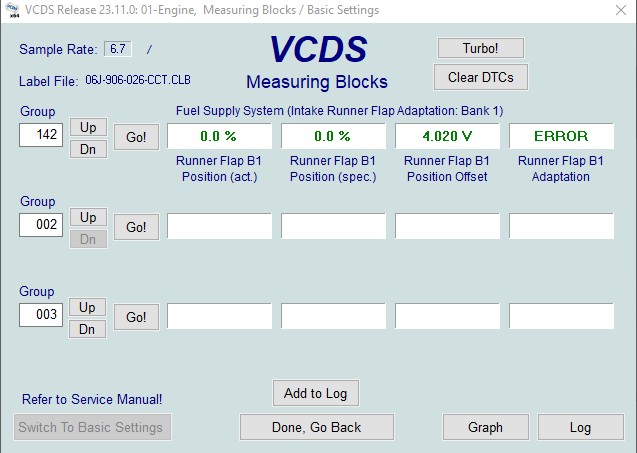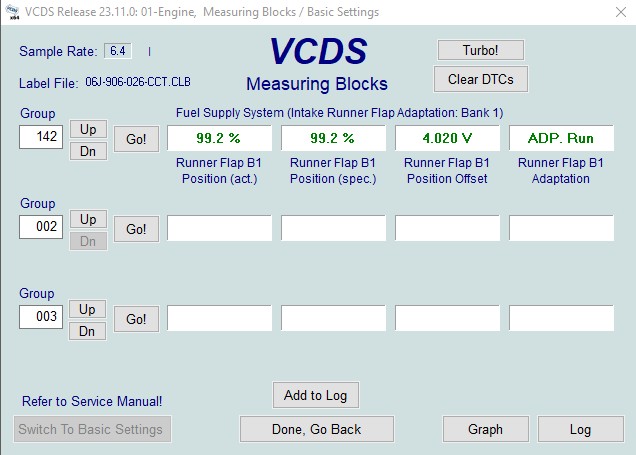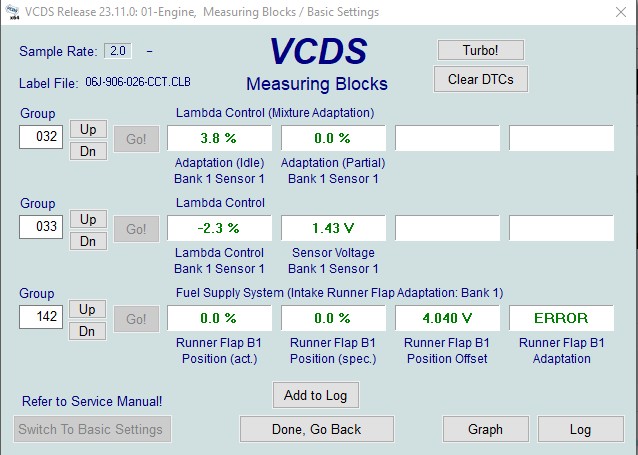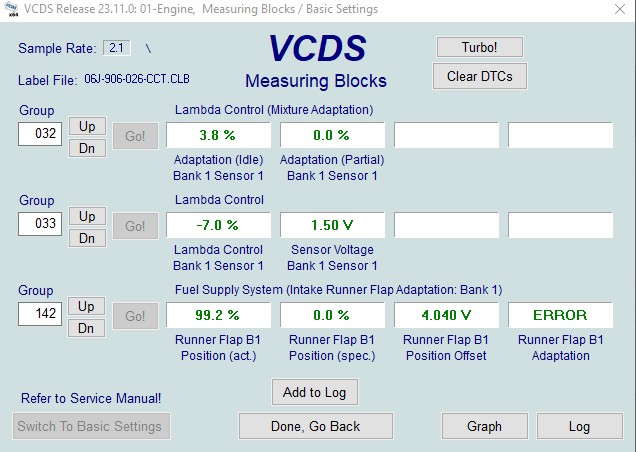Intake Manifold Adaptation Vcds can be tricky, but with the right approach and expert assistance from CAR-CODING.EDU.VN, you can ensure accurate calibration and optimal engine performance. We provide comprehensive remote support for technicians facing challenges with ECU programming, enabling seamless activation of hidden features and permanent clearing of fault codes.
Contents
- 1. What is Intake Manifold Adaptation VCDS?
- 1.1 Why is Intake Manifold Adaptation Necessary?
- 1.2 What Happens If Adaptation is Not Performed?
- 2. What are the Common Symptoms Indicating the Need for Intake Manifold Adaptation?
- 3. What Tools are Needed for Intake Manifold Adaptation VCDS?
- 4. Step-by-Step Guide to Performing Intake Manifold Adaptation VCDS
- 4.1 Preparation
- 4.2 Connecting with VCDS
- 4.3 Performing the Adaptation
- 4.4 Verifying Adaptation
- 4.5 Example: Adaptation on a VW GTI
- 5. What are the Common Issues During Intake Manifold Adaptation VCDS?
- 5.1 Adaptation Not Possible
- 5.2 Adaptation Error
- 5.3 Incorrect Adaptation Values
- 5.4 VCDS Communication Issues
- 6. What are the Common Fault Codes Associated with Intake Manifold Issues?
- 7. How to Diagnose Vacuum Leaks Affecting Intake Manifold Adaptation?
- 8. What is the Role of Fuel Trims in Diagnosing Intake Manifold Issues?
- 8.1 Interpreting Fuel Trim Values
- 8.2 Using Fuel Trims for Diagnosis
- 9. How Does Intake Manifold Flap Angle Affect Engine Performance?
- 9.1 Monitoring Flap Angle
- 10. What Are the Benefits of Remote Assistance for Intake Manifold Adaptation VCDS?
- 11. How Does CAR-CODING.EDU.VN Provide Remote Assistance for VCDS Coding?
- 12. What Types of Vehicles and ECUs Does CAR-CODING.EDU.VN Support?
- 13. What Hidden Features Can Be Activated with VCDS Coding?
- 13.1 Example of Coding Features by Car Model
- 14. How to Ensure Safety During VCDS Coding and Adaptation?
- 15. What is the Cost of Remote Assistance for VCDS Coding from CAR-CODING.EDU.VN?
- 16. How to Clear Fault Codes Permanently with VCDS?
- 17. Why Choose CAR-CODING.EDU.VN for Remote Car Coding Assistance?
- 18. What are the Future Trends in Car Coding and ECU Programming?
- 19. What are the Ethical Considerations in Car Coding and ECU Programming?
- 20. Frequently Asked Questions (FAQ) about Intake Manifold Adaptation VCDS
- 20.1 Is it safe to perform intake manifold adaptation VCDS myself?
- 20.2 How long does intake manifold adaptation VCDS take?
- 20.3 Can intake manifold adaptation VCDS improve fuel economy?
- 20.4 What happens if the adaptation fails?
- 20.5 What are the common reasons for adaptation failure?
- 20.6 How can CAR-CODING.EDU.VN help with intake manifold adaptation?
- 20.7 What types of vehicles does CAR-CODING.EDU.VN support?
- 20.8 How much does remote assistance cost?
- 20.9 What tools are required for remote assistance?
- 20.10 Is my vehicle compatible with remote coding assistance?
1. What is Intake Manifold Adaptation VCDS?
Intake manifold adaptation using VCDS (VAG-COM Diagnostic System) is the process of calibrating the intake manifold flap motor to ensure it operates correctly. This adaptation is crucial for optimizing engine performance, fuel efficiency, and reducing emissions in vehicles equipped with variable intake manifold systems. The adaptation process involves teaching the Engine Control Unit (ECU) the correct operating range of the intake manifold flap, allowing it to control the airflow into the engine effectively.
1.1 Why is Intake Manifold Adaptation Necessary?
Intake manifold adaptation is necessary for several reasons:
- Component Replacement: When the intake manifold, intake manifold flap motor, or ECU is replaced, the adaptation ensures the new components are correctly synchronized.
- Fault Code Clearing: After addressing issues related to the intake manifold, performing an adaptation helps clear related fault codes and ensures the issue is resolved.
- Engine Performance: Proper adaptation ensures the intake manifold flaps operate within the correct parameters, optimizing engine performance across different RPM ranges.
- Fuel Efficiency: Accurate adaptation helps the engine manage airflow efficiently, leading to improved fuel economy.
1.2 What Happens If Adaptation is Not Performed?
If intake manifold adaptation is not performed or is done incorrectly, several issues can arise:
- Reduced Engine Performance: The engine may experience a decrease in power and torque, especially at specific RPM ranges.
- Poor Fuel Economy: Inefficient airflow management can lead to increased fuel consumption.
- Fault Codes and CEL: The vehicle may display fault codes related to the intake manifold, triggering the Check Engine Light (CEL).
- Rough Idling: The engine may idle roughly due to improper airflow control.
2. What are the Common Symptoms Indicating the Need for Intake Manifold Adaptation?
Several symptoms can indicate that an intake manifold adaptation is necessary:
- Check Engine Light (CEL): A lit CEL is often the first sign, accompanied by relevant fault codes.
- Fault Codes: Specific fault codes related to the intake manifold flap, such as “Intake Manifold Flap Stuck Open” or adaptation errors.
- Poor Engine Performance: Noticeable loss of power or torque.
- Rough Idling: Unstable or rough idling, especially when the engine is cold.
- Increased Fuel Consumption: A sudden or gradual decrease in fuel economy.
- Hesitation During Acceleration: The engine may hesitate or stumble during acceleration.
3. What Tools are Needed for Intake Manifold Adaptation VCDS?
To perform an intake manifold adaptation using VCDS, you will need the following tools:
- VCDS Interface: A genuine VCDS interface cable from Ross-Tech is essential for reliable communication with the vehicle’s ECU.
- Laptop with VCDS Software: A laptop with the VCDS software installed. Ensure the software is up to date for the best compatibility and features.
- Vehicle: The vehicle requiring the intake manifold adaptation.
- Battery Charger (Optional): A stable power supply can prevent issues during the adaptation process, especially for older vehicles.
4. Step-by-Step Guide to Performing Intake Manifold Adaptation VCDS
Here’s a detailed guide on how to perform intake manifold adaptation using VCDS:
4.1 Preparation
- Vehicle Condition: Ensure the vehicle is in good mechanical condition with no other major issues.
- Battery Voltage: Verify the battery voltage is stable (ideally above 12.5V). Use a battery charger if necessary.
- Software and Interface: Ensure VCDS software is installed correctly and the interface cable is connected to the laptop and vehicle.
- Ignition On: Turn the ignition on, but do not start the engine.
4.2 Connecting with VCDS
- Select Control Module: Open VCDS and select the “Select” button.
- Engine Module: Choose the “01-Engine” control module.
- Basic Settings: Click on the “Basic Settings – 04” button.
4.3 Performing the Adaptation
- Select Adaptation Group: Enter the appropriate group number for the intake manifold adaptation. This number can vary depending on the vehicle model and engine type. Common group numbers include “142,” “060,” or “098.” Consult the Ross-Tech Wiki or your vehicle’s repair manual for the correct group number.
- Start Adaptation: Click the “Go!” button to start the adaptation process. VCDS will display the current and target values.
- Monitor Progress: Observe the adaptation process. VCDS will show messages indicating the progress and status.
- Wait for Completion: Allow the adaptation to complete. This may take a few minutes. Do not interrupt the process.
- Check Results: Once the adaptation is complete, VCDS will display a message indicating whether the adaptation was successful.
4.4 Verifying Adaptation
- Check for Fault Codes: After the adaptation, check for any new or remaining fault codes. Clear any codes if necessary.
- Test Drive: Perform a test drive to ensure the engine is running smoothly and the issue is resolved. Monitor engine performance and fuel economy.
4.5 Example: Adaptation on a VW GTI
For a 2010 VW GTI, the process might look like this:
- Connect VCDS and select the “01-Engine” module.
- Go to “Basic Settings – 04.”
- Enter group number “142” (or the appropriate number for your engine code).
- Start the adaptation and wait for completion.
- Check for fault codes and perform a test drive.
 VCDS Interface Connected to a Car for Adaptation
VCDS Interface Connected to a Car for Adaptation
5. What are the Common Issues During Intake Manifold Adaptation VCDS?
During the intake manifold adaptation process, you might encounter several issues. Here’s how to troubleshoot them:
5.1 Adaptation Not Possible
- Problem: VCDS displays a message indicating that adaptation is not possible.
- Possible Causes:
- Incorrect group number.
- Engine not at the correct temperature.
- Fault codes preventing adaptation.
- Solutions:
- Verify the correct group number.
- Ensure the engine is at the required temperature (usually specified in the VCDS documentation).
- Clear any fault codes and address the underlying issues.
5.2 Adaptation Error
- Problem: VCDS displays an error message during or after the adaptation process.
- Possible Causes:
- Mechanical issues with the intake manifold flap.
- Vacuum leaks.
- Electrical problems with the flap motor.
- Solutions:
- Inspect the intake manifold flap for mechanical damage or obstructions.
- Check for vacuum leaks using a smoke tester or by visually inspecting vacuum lines.
- Test the flap motor for proper operation and electrical continuity.
5.3 Incorrect Adaptation Values
- Problem: The adaptation completes successfully, but the engine still exhibits issues.
- Possible Causes:
- Underlying mechanical issues.
- Incorrect adaptation settings.
- Solutions:
- Double-check the adaptation settings and group number.
- Perform a thorough inspection of the intake manifold and related components.
5.4 VCDS Communication Issues
- Problem: VCDS cannot communicate with the ECU.
- Possible Causes:
- Faulty VCDS interface cable.
- Incorrect COM port settings.
- ECU issues.
- Solutions:
- Ensure the VCDS interface cable is properly connected.
- Verify the correct COM port settings in VCDS.
- Check the ECU for any electrical or software issues.
 Screenshot of VCDS Showing Adaptation Error
Screenshot of VCDS Showing Adaptation Error
6. What are the Common Fault Codes Associated with Intake Manifold Issues?
Several fault codes are commonly associated with intake manifold issues. Understanding these codes can help diagnose the problem more effectively.
- P2004: Intake Manifold Flap; Bank 1: Stuck Open
- P2005: Intake Manifold Flap; Bank 2: Stuck Open
- P2006: Intake Manifold Flap; Bank 1: Stuck Closed
- P2007: Intake Manifold Flap; Bank 2: Stuck Closed
- P2015: Intake Manifold Runner Position Sensor/Switch Circuit Range/Performance
- P10A4: Intake Manifold Runner Control: Basic Setting not Completed
- 008196: Intake Manifold Flap; Bank 1: Stuck Open
7. How to Diagnose Vacuum Leaks Affecting Intake Manifold Adaptation?
Vacuum leaks can significantly affect intake manifold adaptation. Here’s how to diagnose them:
- Visual Inspection: Check all vacuum lines and connections for cracks, breaks, or loose fittings.
- Smoke Test: Use a smoke tester to introduce smoke into the intake system. Observe where the smoke escapes to identify leaks.
- Vacuum Gauge: Use a vacuum gauge to measure the vacuum pressure at various points in the intake system. Compare the readings to the manufacturer’s specifications.
- Carb Cleaner Spray: Spray carb cleaner around vacuum lines and connections while the engine is running. Listen for changes in engine RPM, which can indicate a leak.
 Checking Vacuum Lines for Leaks
Checking Vacuum Lines for Leaks
8. What is the Role of Fuel Trims in Diagnosing Intake Manifold Issues?
Fuel trims provide valuable information about the engine’s air-fuel mixture. Analyzing fuel trims can help diagnose intake manifold issues:
- Long-Term Fuel Trim (LTFT): Indicates the overall adjustments the ECU is making to compensate for deviations in the air-fuel mixture over time.
- Short-Term Fuel Trim (STFT): Indicates the immediate adjustments the ECU is making to maintain the correct air-fuel mixture.
8.1 Interpreting Fuel Trim Values
- Positive Fuel Trims: Indicate that the engine is running lean (too much air, not enough fuel). This could be due to vacuum leaks, faulty MAF sensor, or low fuel pressure.
- Negative Fuel Trims: Indicate that the engine is running rich (too much fuel, not enough air). This could be due to faulty injectors, high fuel pressure, or a contaminated air filter.
8.2 Using Fuel Trims for Diagnosis
- Identify the Issue: Monitor STFT and LTFT values at idle and under load. Significant deviations from 0% can indicate an issue.
- Locate the Source: Use fuel trim values in conjunction with other diagnostic techniques to pinpoint the source of the problem. For example, high positive fuel trims combined with a rough idle could indicate a vacuum leak.
9. How Does Intake Manifold Flap Angle Affect Engine Performance?
The intake manifold flap angle plays a critical role in optimizing engine performance across different RPM ranges. The flaps control the length and shape of the intake runners, which affects the airflow into the cylinders.
- Low RPM: At low RPMs, the flaps are typically closed or partially closed to increase the intake runner length. This enhances torque and improves throttle response.
- High RPM: At high RPMs, the flaps are fully open to shorten the intake runner length. This maximizes airflow and increases horsepower.
9.1 Monitoring Flap Angle
VCDS allows you to monitor the actual and specified flap angles. Discrepancies between these values can indicate issues with the flap motor, vacuum lines, or the ECU.
 Monitoring Intake Manifold Flap Angle in VCDS
Monitoring Intake Manifold Flap Angle in VCDS
10. What Are the Benefits of Remote Assistance for Intake Manifold Adaptation VCDS?
Remote assistance from CAR-CODING.EDU.VN offers several benefits for technicians performing intake manifold adaptation VCDS:
- Expert Guidance: Access to experienced professionals who can provide step-by-step guidance throughout the adaptation process.
- Real-Time Support: Immediate assistance to troubleshoot issues and resolve errors during adaptation.
- Cost-Effective: Avoid the expense of sending vehicles to dealerships or specialized workshops.
- Time-Saving: Expedite the adaptation process and reduce downtime.
- Comprehensive Coverage: Support for a wide range of vehicle makes and models.
- Reduced Risk: Minimize the risk of damaging the ECU or other components during adaptation.
11. How Does CAR-CODING.EDU.VN Provide Remote Assistance for VCDS Coding?
CAR-CODING.EDU.VN offers comprehensive remote assistance for VCDS coding through the following process:
- Initial Contact: Technicians contact CAR-CODING.EDU.VN via WhatsApp (+1 (641) 206-8880) or through our website CAR-CODING.EDU.VN to request assistance.
- Diagnostic Assessment: Our experts gather information about the vehicle, fault codes, and the specific adaptation or coding task.
- Remote Connection: Using secure remote access tools, our technicians connect to the vehicle’s diagnostic system.
- Step-by-Step Guidance: We provide real-time guidance and instructions, ensuring the technician performs each step correctly.
- Troubleshooting: If any issues arise, our experts provide immediate troubleshooting and solutions.
- Verification: After completing the adaptation or coding, we verify the results to ensure everything is functioning correctly.
12. What Types of Vehicles and ECUs Does CAR-CODING.EDU.VN Support?
CAR-CODING.EDU.VN supports a wide range of vehicle makes and models, including:
- Volkswagen (VW)
- Audi
- Skoda
- SEAT
- BMW
- Mercedes-Benz
- And many more
We also support various ECU types, including:
- Engine Control Units (ECU)
- Transmission Control Units (TCU)
- Body Control Modules (BCM)
- ABS Control Units
- Airbag Control Units
Our expertise covers a broad spectrum of coding and adaptation tasks, ensuring comprehensive support for diverse vehicle systems.
13. What Hidden Features Can Be Activated with VCDS Coding?
VCDS coding allows technicians to activate various hidden features in vehicles, enhancing functionality and personalization. Some popular hidden features include:
- Cornering Lights: Activate fog lights to illuminate when turning.
- Coming Home/Leaving Home Lights: Automatically turn on headlights when unlocking or locking the vehicle.
- Gauge Staging/Needle Sweep: Sweep the instrument cluster needles upon startup.
- Seatbelt Warning Disable: Disable the seatbelt warning chime.
- Emergency Brake Flashing: Activate hazard lights to flash during hard braking.
- Window Operation with Remote: Control windows using the remote key fob.
- Folding Mirrors on Lock: Automatically fold side mirrors when locking the vehicle.
13.1 Example of Coding Features by Car Model
| Make | Model | Coding Feature |
|---|---|---|
| Volkswagen | Golf/GTI | Cornering Lights |
| Audi | A4/S4 | Gauge Staging/Needle Sweep |
| Skoda | Octavia | Coming Home/Leaving Home Lights |
| SEAT | Leon | Seatbelt Warning Disable |
| BMW | 3 Series | Folding Mirrors on Lock |
| Mercedes-Benz | C-Class | Emergency Brake Flashing |
14. How to Ensure Safety During VCDS Coding and Adaptation?
Safety is paramount when performing VCDS coding and adaptation. Follow these guidelines to ensure a safe and successful process:
- Use Genuine Equipment: Always use a genuine VCDS interface cable from Ross-Tech to ensure reliable communication with the vehicle’s ECU.
- Stable Power Supply: Maintain a stable power supply to prevent voltage fluctuations during coding.
- Follow Instructions Carefully: Adhere to the instructions provided by VCDS and CAR-CODING.EDU.VN experts.
- Backup ECU Data: Before making any changes, back up the ECU data to prevent data loss in case of errors.
- Verify Compatibility: Ensure the coding changes are compatible with the vehicle’s make, model, and ECU version.
- Monitor Progress: Observe the coding process closely and address any errors promptly.
15. What is the Cost of Remote Assistance for VCDS Coding from CAR-CODING.EDU.VN?
The cost of remote assistance for VCDS coding from CAR-CODING.EDU.VN varies depending on the complexity of the task and the time required. Contact us via WhatsApp (+1 (641) 206-8880) or through our website CAR-CODING.EDU.VN for a personalized quote. We offer competitive pricing and flexible payment options to suit your needs.
16. How to Clear Fault Codes Permanently with VCDS?
Clearing fault codes permanently with VCDS involves addressing the underlying issues that caused the codes and then using VCDS to clear them. Here’s how:
- Identify and Resolve the Issue: Diagnose and repair the problem causing the fault code.
- Connect VCDS: Connect the VCDS interface cable to the vehicle and laptop.
- Select Control Module: Open VCDS and select the appropriate control module (e.g., Engine, ABS, Airbag).
- Read Fault Codes: Click on the “Fault Codes – 02” button to read the stored fault codes.
- Clear Fault Codes: Click on the “Clear Codes – 05” button to clear the fault codes.
- Verify Clearance: After clearing the codes, check again to ensure the codes have been successfully cleared.
- Test Drive: Perform a test drive to ensure the issue is resolved and the fault codes do not reappear.
17. Why Choose CAR-CODING.EDU.VN for Remote Car Coding Assistance?
CAR-CODING.EDU.VN stands out as a premier provider of remote car coding assistance due to our:
- Expertise: Our team comprises highly skilled and experienced car coding specialists.
- Reliability: We provide dependable and accurate coding solutions.
- Comprehensive Support: We offer support for a wide range of vehicle makes, models, and ECUs.
- Affordable Pricing: Our services are competitively priced to provide excellent value.
- Customer Satisfaction: We prioritize customer satisfaction and strive to exceed expectations.
18. What are the Future Trends in Car Coding and ECU Programming?
The field of car coding and ECU programming is constantly evolving. Some future trends include:
- Increased Complexity: As vehicles become more technologically advanced, the complexity of coding and programming will increase.
- Over-the-Air (OTA) Updates: More vehicles will support OTA updates for software and ECU programming.
- Cybersecurity: Enhanced cybersecurity measures will be implemented to protect vehicle systems from unauthorized access.
- Artificial Intelligence (AI): AI will play a greater role in diagnosing and resolving coding issues.
- Electric Vehicle (EV) Coding: The demand for EV-specific coding and programming will continue to grow.
19. What are the Ethical Considerations in Car Coding and ECU Programming?
Ethical considerations are crucial in car coding and ECU programming. It is essential to:
- Obtain Consent: Always obtain the vehicle owner’s consent before making any coding changes.
- Transparency: Be transparent about the changes being made and their potential impact.
- Avoid Illegal Modifications: Refrain from making modifications that violate local laws or regulations.
- Protect Vehicle Safety: Ensure that coding changes do not compromise vehicle safety or performance.
- Respect Intellectual Property: Respect the intellectual property rights of vehicle manufacturers and software developers.
20. Frequently Asked Questions (FAQ) about Intake Manifold Adaptation VCDS
Here are some frequently asked questions about intake manifold adaptation VCDS:
20.1 Is it safe to perform intake manifold adaptation VCDS myself?
Performing intake manifold adaptation VCDS can be safe if you have the necessary tools, knowledge, and follow instructions carefully. However, if you are not experienced, it is best to seek professional assistance from CAR-CODING.EDU.VN to avoid potential issues.
20.2 How long does intake manifold adaptation VCDS take?
The adaptation process typically takes a few minutes to complete. However, the exact duration can vary depending on the vehicle model and ECU type.
20.3 Can intake manifold adaptation VCDS improve fuel economy?
Yes, proper intake manifold adaptation can improve fuel economy by optimizing airflow management.
20.4 What happens if the adaptation fails?
If the adaptation fails, the engine may exhibit performance issues, and fault codes may be stored. It is essential to troubleshoot the issue and repeat the adaptation process.
20.5 What are the common reasons for adaptation failure?
Common reasons for adaptation failure include incorrect settings, mechanical issues, vacuum leaks, and electrical problems.
20.6 How can CAR-CODING.EDU.VN help with intake manifold adaptation?
CAR-CODING.EDU.VN provides remote assistance from experienced professionals who can guide you through the adaptation process, troubleshoot issues, and ensure a successful outcome.
20.7 What types of vehicles does CAR-CODING.EDU.VN support?
CAR-CODING.EDU.VN supports a wide range of vehicle makes and models, including Volkswagen, Audi, Skoda, SEAT, BMW, and Mercedes-Benz.
20.8 How much does remote assistance cost?
The cost of remote assistance varies depending on the complexity of the task. Contact us for a personalized quote.
20.9 What tools are required for remote assistance?
To receive remote assistance, you will need a laptop, a VCDS interface cable, and a stable internet connection.
20.10 Is my vehicle compatible with remote coding assistance?
Most modern vehicles are compatible with remote coding assistance. Contact CAR-CODING.EDU.VN to verify compatibility for your specific vehicle.
Don’t let intake manifold adaptation challenges slow you down. Contact CAR-CODING.EDU.VN today at +1 (641) 206-8880 or visit our website CAR-CODING.EDU.VN for expert remote assistance. Our office is located at 100 Tech Innovation Dr, Suite 500, San Jose, CA 95110, United States. Let us help you ensure accurate calibration and optimal engine performance!